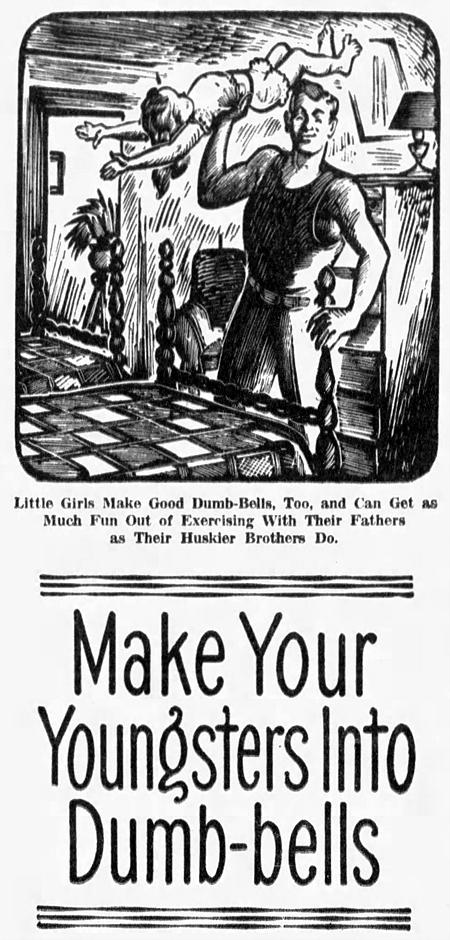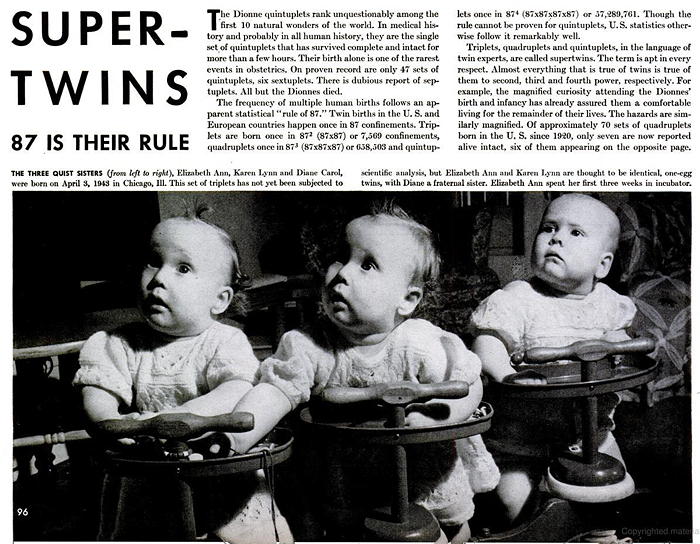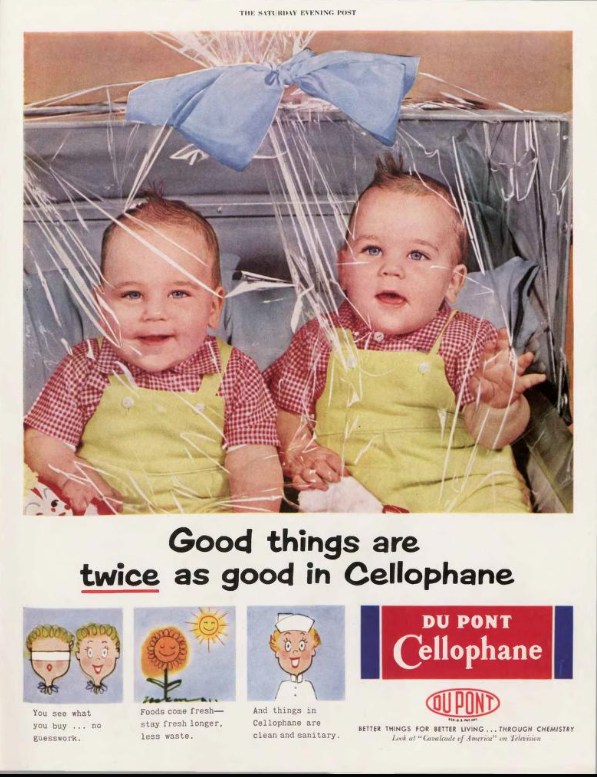Babies
Sounds of the Unborn
Musician Luca Yupanqui is releasing her first album, Sounds of the Unborn, in April.Though she had some help from her parents. Luca was still in her mother's womb when her parents recorded her in utero using electrodes and then used "biosonic MIDI technology" to transform the sounds into something like music.
It's being promoted as the "world’s first LP made from sounds inside the womb".
More info: The Guardian
Posted By: Alex - Tue Feb 16, 2021 -
Comments (1)
Category: Babies, Music
Use your children as dumbbells
Harold J. Reilly, owner of a New York gym during the 1930s and 40s, promoted the idea of using children as exercise equipment. Pick them up and swing them around, he urged parents, as one would a dumbbell or kettlebell.The advantage of using kids as dumbbells, he pointed out, was that as they grow older their weight will increase, thereby naturally helping the parents to develop their strength.
It's an intriguing idea, although a set of dumbbells is a lot cheaper than having children. And won't break if you drop them.

Minneapolis Star - May 31, 1942

"Reilly recommends that parents (or grandparents) work out by swinging their youngsters around from childhood. Says it helps both out."
NY Daily News - May 2, 1948

Pittsburgh Sun-Telegraph - Aug 3, 1941
Some years ago Mr. Reilly was thumbing through a volume of Greek mythology when he read how Hercules, as a boy, started lifting a small calf every day. As the calf grew, so did Hercules' strength so that when it became a full-grown bull Hercules could still lift it.
Mr. Reilly thought that the story could be given a modern twist and proceeded to do so. He became "Hercules" and his infant son and daughter the small "calves."...
For years he carried out this theory conscientiously with his own children and it worked so well that it prompted him to write a recent book about physical culture in which he advocates that both fathers and children will benefit greatly if the former raise the latter as dumb-bells.
"I'm not suggesting that you bring a bull calf into the house and go to work on it. After all you're not Hercules," Mr. Reilly points out in "The Secret of Better Health," published by Carlyle House, "But you can work out the same idea by starting to exercise with your pride and joy when he's only a year old, and keeping it up until he's ten, 15 or even 20. The child will benefit, and so will you...
"You may start when your child is an infant," says Mr. Reilly. "But as babies are delicate, don't begin by wrestling with him. Just manipulate the baby's arms and legs. Wiggle them around, being careful not to twist harshly... Then as the child begins to walk, you can swing him by the arms."...
"From three to six, you can become a little more strenuous. Pick the child up and swing him around, holding him by the arms. Let him lie on his back and take his two hands in one of yours and his ankles in the other and swing him around that way, back and forth, sideways and between your legs as though he were a medicine ball...
Mr. Reilly says that the swinging-around game should be kept up during the six-to-nine period of the child's age. In addition he should be picked up by the ankles and walked around, wheelbarrow fashion...
"From nine to 15 keep up the same exercises, if you can, and begin to box and wrestle with him," says Mr. Reilly. "It is just as easy with a daughter, for a little girl is a natural tomboy. She doesn't begin to be a female until around 12 years when adolescence sets in. Then a certain amount of care is necessary. But until then, treat your daughter the same as your son."
Update: Found a video of a guy using his kids as weights.
Posted By: Alex - Tue Jan 26, 2021 -
Comments (4)
Category: Babies, Exercise and Fitness, Babies and Toddlers, Children, 1940s
The Rule of 87
This "Rule of 87" may have been true in the mid-twentieth century, but I'm guessing that the rise of fertility drugs played havoc with it.
I'll also note that the Minnesota Twins won the 1987 World Series. Coincidence?

Posted By: Alex - Fri Oct 02, 2020 -
Comments (3)
Category: Babies, Science
Baby and Cockroach
In 2003, the UK children's charity Barnardo's came out with the ad below. It promptly triggered numerous complaints to the Advertising Standards Authority. Barnardo's argued that it "caused distress for good reason, but the ASA banned the ad anyway, saying it could "cause serious or widespread offense."The ad was subsequently voted one of the top 10 ads of 2003 by Campaign magazine.
Of course, the charity must have known it was likely the ad would get banned, but evidently figured the controversy would attract more attention to their message than something more subdued.

Posted By: Alex - Sat Aug 15, 2020 -
Comments (3)
Category: Babies, Charities and Philanthropy, Insects and Spiders, Advertising, Nausea, Revulsion and Disgust
Follies of the Madmen #485

No infants were harmed in the making of this ad. Oh, wait a minute, they're not breathing...
Source.
Posted By: Paul - Sat Aug 08, 2020 -
Comments (1)
Category: Babies, Business, Advertising, Death, 1950s, Goofs and Screw-ups
Mother Heart
Japan's "crazy inventor" Hiroshi Majima invented this odd device:The tot apparently feels secure and reassured, stops yelling and drifts off to sleep without another whimper.
Bed-wetting is also greatly reduced, inventor Majima finds.
"Mother Heart" now sells abroad, not just on Japan's domestic market alone. Ready-made markets, Majima says, have been found in the Mediterranean countries, like France, Italy, and Spain, where mothers are especially close to their infants, and vice versa.


Allentown Morning Call - Sep 16, 1965
We previously featured another one of Majima's strange inventions on WU: the Cat Mew Machine.
Posted By: Alex - Wed Jul 29, 2020 -
Comments (0)
Category: Babies, Inventions, 1960s
Coffin Cradle

From the Strand Magazine - Vol 8, 1894:
Posted By: Alex - Tue May 12, 2020 -
Comments (2)
Category: Babies, Death, Furniture
The screaming baby in the classroom prank
I don't think this would go over well nowadays. From the Iowa City Press-Citizen - May 12, 1975:To liven them up Johnson does this:
“I start the lecture by playing a stereo recording from Sesame Street, which awakens about a third of the audience. I briefly outline the two-hour lecture and then, on cue, in comes the first patient... a newborn in a wheeled isolette pushed by a nurse.
“For the pediatrician,” I announce, “this is where it all begins.”
The baby then starts to scream. As it gets louder and louder Johnson becomes more and more annoyed.
At first he rocks the isolette gently, then with more vigor. Finally, in a fit of anger he flings open the glass top, seizes the infant, and throws it out into the audience.
Pandemonium!
“When the hysteria dies down I state: ‘Infants are helpless parasites. They can be and are battered.’
“Most of my other pearls are soon forgotten, but rarely does the student forget the ‘helpless parasite’ flying into the audience. All that’s needed is a straight-faced nurse, a good tape recording of an infant yelling — and a life-size doll.
Posted By: Alex - Sat Mar 07, 2020 -
Comments (4)
Category: Babies, 1970s, Universities, Colleges, Private Schools and Academia, Pranks
Diapers with pistol holsters
Patented by Harriet Y. Clough of Meadville, Pennsylvania in 1958.
Posted By: Alex - Sun Jan 26, 2020 -
Comments (0)
Category: Babies, Guns, Inventions, Patents
Dirty diapers as art
Artist Mary Kelly’s 1976 exhibit at the Insitute of Contemporary Art in London consisted of a framed series of soiled liners from her kid’s diapers. Below the fecal stains, she listed what her kid had eaten in order to produce the marks.The exhibit provoked outrage. Siona Wilson, in her book Art Labor, Sex Politics: Feminist Effects in 1970s British Art and Performance, notes, "Kelly was forced to go into hiding for a time to avoid the unwanted media attention."
More info: vice.com, MaryKellyArtist.com


The Twin Falls Times-News - Oct 17, 1976
Posted By: Alex - Mon Nov 11, 2019 -
Comments (0)
Category: Art, Babies, 1970s

| Who We Are |
|---|
| Alex Boese Alex is the creator and curator of the Museum of Hoaxes. He's also the author of various weird, non-fiction, science-themed books such as Elephants on Acid and Psychedelic Apes. Paul Di Filippo Paul has been paid to put weird ideas into fictional form for over thirty years, in his career as a noted science fiction writer. He has recently begun blogging on many curious topics with three fellow writers at The Inferior 4+1. Contact Us |




